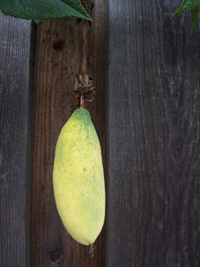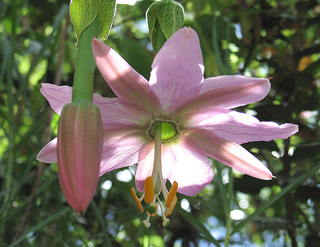Human Flower Project
HFQ #6: Fit for Foraging?

Georgia Silvera Seamans, local ecologist of Berkeley, California, writes:
Spotted this vine with fruit over the weekend. Reminds me of a mango but as an avid mango eater (we had two mango trees in our back yard in Jamaica) I know it’s not a mango (tree!). I am hoping it’s human-edible so I can forage to exchange with Forage Oakland.

Hanging fruit in Berkeley’s Elmwood neighborhood:
Photo: Georgia Silvera Seamans
No popping off on this Human Fruit Query, folks; Georgia’s considering not only eating this herself but helping her neighbors to some also, through this interesting Bay Area group. Seems that they come together around the usefulness of local plants, much like the amazing Scooter Cheatham and Lynn Marshall here in Austin. (In the past, Scooter and Lynn have hosted “weedfeeds”—potluck meals where all the dishes are made from wild plants).
 At right is a close up of the fruit. Anyone know it? Anyone digested it?
At right is a close up of the fruit. Anyone know it? Anyone digested it?
We did some digital grazing and learned that on Oakland’s east side there are many fruit trees, originally planted by Italian, Greek and Portuguese families who baked and canned and jammed the produce.
“People are too busy and too tired to pick peaches or peel, slice, core and stew apples,” says the Oakbook. “The problem is—no one told the trees, which means—the fruit still falls in the backyards. More often than not, it rots.”
In 2007, a group called PUEBLO organized and hired a few teenagers to pick the fruit and bike it to nearby senior citizen centers. The program was such a success its first year (harvesting more than 350 pounds of apples, plums, peaches, citrus and pomegranate) that in 2008 the number of pickers was doubled. So far as we know PUEBLO will harvest and deliver again this summer.
Georgia, these folks probably could tell you just what this vine is. And we’ll take a stab at it, too.
 Banana passionfruit flower
Banana passionfruit flower
Passaflora mollissima
Photo: Quimbaya
Did you happen to catch sight of any of these gorgeous flowers? Our best guess is Passiflora mollissima, banana passionfruit. Purdue’s site offers some tasty specifics about how banana passionfruit is enjoyed in South America: “The pulp is eaten out-of-hand or is strained for its juice, which is not consumed alone but employed in refreshing mixed cold beverages. In Bolivia, the juice, combined with aguardiente and sugar, is served as a pre-dinner cocktail. Colombians strain out the seeds and serve the pulp with milk and sugar, or use it in gelatin desserts. In Ecuador, the pulp is made into ice cream.”
This Hawaii-centric site is less jovial: apparently Passiflora mollissima is considered an invasive plant in the islands.
We’ve spotted a number of banana passionfruit photos taken in the Bay Area, including several shots from the San Francisco Botanical Garden. We’ve also learned that there are a lot of passionfruit varieties out there, many of them yellow. And we could be way off. Please ask an expert before biting down.
We hope to hear from aficionadas of passionfruits, frigid fruits, and other quasi-edibles before Georgia’s foraging gets “out-of-hand.”
Comments
Our expert friends think it is Passiflora tarminiana. See the comments on <a href=“http://agro.biodiver.se/2009/03/do-you-know-this-fruit/”>this post</a >.
Passiflora sp. is my guess, too.
Ahhh foraging… we do a lot of it here in Sarasota, Florida, where you would think residents would be more interested in eating their tangelos, carambolas, papayas, & passionfuits than in watching the squirrels and racoons get them.
With so many people lining up at the food-banks, it’s amazing to us that we don’t see more people trying to gather the fruit-fall in their own back yards—to share, if not to enjoy themselves.
This discussion reminds me of another fruit ripening right now; it’s one that even long-time Florida residents seem to ignore: loquats, aka Eryobotria japonica. Tartly sweet, with many of the same flavor notes as apricots or plums,loquats are absolutely delicious and easy to pluck and pit.
In Turkey, cooks grill loquats with lamb—on skewers—just as we add peppers and onions to our kebabs. (A bunch of my people will be touring Turkey this April & May with National Public Radio’s Ketzel Levine as she explores the botanical bonanza of flowering bulb plants in the Aegean region.)
Even if you don’t yet have a taste for loquats, but if food and plants grab you—- check out Turkey, a forager’s heaven:
http://hollychase.com/ketzel-levines-botanical-tours/
Thank you Julie and HFP/ HFQ readers! I am pleased that the fruit is human edible. I wonder: does the fruit taste like a banana?
P.S. Hello Holly. Loquats are ripening in Berkeley, too.


It seems to me that you are right, common name in Ecuador is “taxo” I guess that due to climatic factors the fruit is not ripen in the plant (turning yellow).